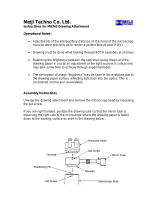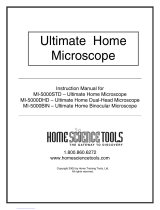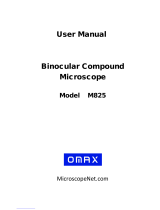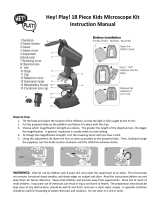Page is loading ...

MT-30 & MT-90 Series
Advanced Academic Microscopes/ Advanced Academic Polarizing Microscope
INSTRUCTION MANUAL

Introduction
With your purchase of an MT-30/MT-90 series type
microscope you have chosen for a quality product.
The MT-30/MT-90 series type microscopes are
developed for use at schools and laboratories.
The maintenance requirement is limited when using
the microscope in a decent manner.
This manual describes the construction of the
microscope, how to use the microscope and
maintenance of the microscope.
MT-30 & MT-90 Series
Advanced Academic Microscopes/ Advanced Academic Polarizing Microscope
INSTRUCTION MANUAL

MT-30 & MT-90 Series
Advanced Academic Microscopes/ Advanced Academic Polarizing Microscope
INSTRUCTION MANUAL
Construction of the Microscope
The names of the several parts are listed below and
are indicated in the picture on the next page:
A) Tube (mono/bino/trino 360°rotatable)
B) Dioptric adjustment (bino type)
C) Stand arm
D) Revolving nosepiece for 4 objectives
E) Objectives
F) Safety device
G) Object stage (mechanical stage or clips)
H) Tension adjustment
I) Coaxial coarse-and ne adjustment
J) Lamp housing
K) Light dimmer
L) Coaxial stage controls
M) Condenser with irisdiaphragm + lterholder
N) On/O switch (not visible)
O) Eyepiece(s)

MT-30 & MT-90 Series
Advanced Academic Microscopes/ Advanced Academic Polarizing Microscope
INSTRUCTION MANUAL
A
B
C
D
E
F
G
H
I
K
O
N
M
L

MT-30 & MT-90 Series
Advanced Academic Microscopes/ Advanced Academic Polarizing Microscope
INSTRUCTION MANUAL
Functions of the Microscope
The stand consists of a stand arm (C), stand base and an object stage (G).
Hold the microscope at the top of the
stand arm when it should be moved.
Tube
The 360° rotatable tube (either monocular or binocular) is equipped with WF10x eyepiece (s)
(O).
Revolving nosepiece
The revolving nosepiece (D) can be equipped with 4 objectives (E).
Optical specications of the MT-30/MT-90 series range
The MT-30/MT-90 series range microscopes are standard equipped with 1 or 2 wideeld eye-
pieces WF10x (O) and semi-plan-objectives, as mentioned below in table 1.
Optical specicitions, and object stage type:
SMP4x, SMP10x, SMPS40x – Straight stage with 2 object clips
SMP4x, SMP10x, SMPS40x – Coaxial mechanical stage
SMP4x, SMP10x, SMPS60x – Coaxial mechanical stage
SMP4x, SMP10x, SMPS100x – Coaxial mechanical stage
SMP4x, SMP10x, SMPS100x – Coaxial mechanical stage
Table 1
The S40x and S100x objectives are equipped with a spring mount, to prevent damage to the
frontlens and the slide.
The Numeric Aperture - N.A. – of the objective is an indication for the resolving power of the
objective.

MT-30 & MT-90 Series
Advanced Academic Microscopes/ Advanced Academic Polarizing Microscope
INSTRUCTION MANUAL
The total magnication can be calculated by multiplying the magnication of the eyepiece
with the magnication of the objective. The magnications are displayed in the table below:
Eyepiece Objective Magnication
10x 4x 40x
10x 10x 100x
10x 40x 400x
10x 60x 600x
10x 100x 1000x
Object stage
On the basic models the slide is placed beneath the object clips. On the other models into
the clamp of the mechanical stage (G) and can be carefully moved into X- and Y- directions.
Focusing the specimen is done by using the coaxial coarse- and ne adjustment knobs (I).
Coarse- and ne adjustment
The coarse- and ne adjustment knobs (I) for the height adjustment of the object stage are
mounted together on one (1) axle (co-axial). On both ne adjustment knobs there is a gradu-
ation with intervals of 0.002 mm. This can be used to measure depths in a specimen.
Abbe condenser with iris diaphragm
Beneath the object stage an Abbe condenser (M) N.A. 12.5 is mounted. The condenser can
be adjusted in height by means of turning. With this one can focus the light on the specimen
by which the contrast can be optimised. The condenser is factory pre-centered.
The iris diaphragm with lter holder is mounted beneath the condenser. The light intensity
can be adjusted by changing the exible opening.
Illumination MT-30/MT-90 series serie
The LED illumination of the MT-30/MT-90 series is equipped with rechargeable batteries.
The length of use after charging is about 60 hours. The full charging time is about 10 hours.
At First use the batteries have to be fully charged. Connect the cable to the mains socket.
The illumination has the following specications:
• LED : 1W, 300 mA.
• Charger : Primary AC 85 - 265 Volt-50Hz.
• Batteries : 3 NiMh, AA type, 1.2 Volt 1600 - 2000 mA.

MT-30 & MT-90 Series
Advanced Academic Microscopes/ Advanced Academic Polarizing Microscope
INSTRUCTION MANUAL
Preparing the Microscope for Use
Remove the packing and put the microscope on a at
table. The objectives are pre mounted.
Put the plug into the mains supply and switch on the
microscope . Sit comfortably down behind the mi-
croscope and take a relaxed position while viewing
through the eyepieces (O).

MT-30 & MT-90 Series
Advanced Academic Microscopes/ Advanced Academic Polarizing Microscope
INSTRUCTION MANUAL
Working with the Microscope
Please read the following instructions to achieve the best microscope observing results.
Setting the interpupillary- and diopter distance (binocular/trinocular type)
Using a binocular tube is less tiring for the eyes than the use of a monocular tube. In order to
obtain a smooth “compound” image as well as the right interpupillary setting, one should go
through the below steps.
Field of view before Field of view after
adjustment adjustment
• Set the right interpupillary distance by moving the eyepieces towards or away from
each other until a compound eld of view is achieved (see drawing above).
• Close the left side eye and focus looking through the right side eye with the coarse-
and ne adjustment knobs (I)
• Now close the right side eye and focus the left side tube by means of the dioptric
adjustment ring (B).
This procedure should be followed by each individual user.
Setting the illumination
For optimum eect in contrast and resolution one should follow the below procedure:
Place a specimen on the object stage and focus using the 4x objective, with a fully iris
diaphragm.
• Turn the condenser in the highest position.
• Close the iris diaphragm, until it is just visible on the edge of the eld of view.
The microscope is properly set for use with the 4x objective. For each other magnication
this procedure should be repeated to ensure the best balance between contrast and
resolution.

MT-30 & MT-90 Series
Advanced Academic Microscopes/ Advanced Academic Polarizing Microscope
INSTRUCTION MANUAL
Caution:
The maximum light intensity when using the 4x and 10x can damage the eyes!
When changing slides always start with the 4x objective again.
Safety device
To prevent damage to the objective lens, or breaking the slide, all types are equipped with a
pre-xed safety device.
It is recommended to use slides of 1.0 – 1.2 mm thickness in combination with cover glasses
of 0.13 mm or 0.17 mm thickness
Use of the S100x oil-immersion objective
Some of the microscopes are equipped with a S100x N.A. 1.25 oil immersion
objective. Please follow these instructions for using this objective:
• Focus the image with the S40x objective.
• Turn the revolving nosepiece so the S100x objective almost reaches the
click-stop.
• Put a small drop of immersion oil on the centre of the slide.
• Now turn the S100x objective so that you feel the click stop.
• The front lens is in contact with the immersion oil.
• Look through the eyepiece (O) and focus the image with the ne
adjustment knobs (I).
• The distance between the lens of the objective and the slide is only
0.14mm!
• In case there are small bubbles visible turn the S100x objective a couple of
times left/right so that the front of the objective moves in the oil and the
bubbles will disappear.
• After using the S100x objective turn the table (G) with the ne adjustment
knobs (I) downwards until the front lens doesn’t touch the oil any longer.
• Always clean the front lens of the S100x objective with a piece of lens paper
that is moistened with a drop of xylol or alcohol.
• Clean the slide after use as well.

The S100x can also be used without immersion oil (dry). Please be aware of the
fact that in such case the resolution will be much lower!
Caution
• Never put a drop of xylol or alcohol directly on the lens of the objective. It
could enter the objective and dissolve the glue that holds the lenses!
• Avoid oil contact with any of the other objectives!
MT-30 & MT-90 Series
Advanced Academic Microscopes/ Advanced Academic Polarizing Microscope
INSTRUCTION MANUAL

Maintenance and Cleaning
Always place the dustcover over the microscope after use. Keep the eyepiece
and objectives always mounted on the microscope to avoid dust entering the
instrument.
Cleaning the optics
When the eyepiece lens or front lens of the 10x or S40x objective are dirty
they can be cleaned by wiping a piece of lens paper over the surface (circular
movements). When this does not help put a drop of xylol or alcohol on the lens
paper. Never put xylol or alcohol directly on the lens!
When dirt is clearly visible in the eld of view it resides on the lowest lens of the
eyepiece. By using the Allen-key the eyepiece can be removed from the tube.
Clean the outside of the lens.
In case there is still dust visible please check if the dust is in the eyepiece by
turning it. If this is the case remove the lowest lens carefully from the eyepiece
and clean it.
It is not necessary – and not recommended – to clean the lens surfaces at the
inner side of the objectives. Sometimes dust can be removed with high pressured
air. There will never be dust in the objectives if the objectives are not removed
from the revolving nosepiece.
Caution
• Cleaning cloths containing plastic bers can damage the coating of the
lenses!
MT-30 & MT-90 Series
Advanced Academic Microscopes/ Advanced Academic Polarizing Microscope
INSTRUCTION MANUAL

MT-30 & MT-90 Series
Advanced Academic Microscopes/ Advanced Academic Polarizing Microscope
INSTRUCTION MANUAL
Maintenance of the stand
Dust can be removed with a brush. In case the stand or table is really dirty the
surface can be cleaned with a non-aggressive cleaning product.
All moving parts like the height adjustment or the coaxial course and ne
adjustment contain ball bearings that are not dust sensitive. With a drop of
sewing-machine oil the bearing can be lubricated.
Changing the batteries of the MT-30/MT-90 series
Caution: Always remove the power cable from the main supply !
• Remove the smal lid out of the bottom cover of the microscope.
• Place the batteries and put the lid back into its place.
Tension control setting
Between the right-handed coarse adjustment knob and the microscope stand
there is a ring for the tension control setting. By means of turning it clock- or
counter clockwise the tension of the coarse adjustment knobs can be adjusted.
/













